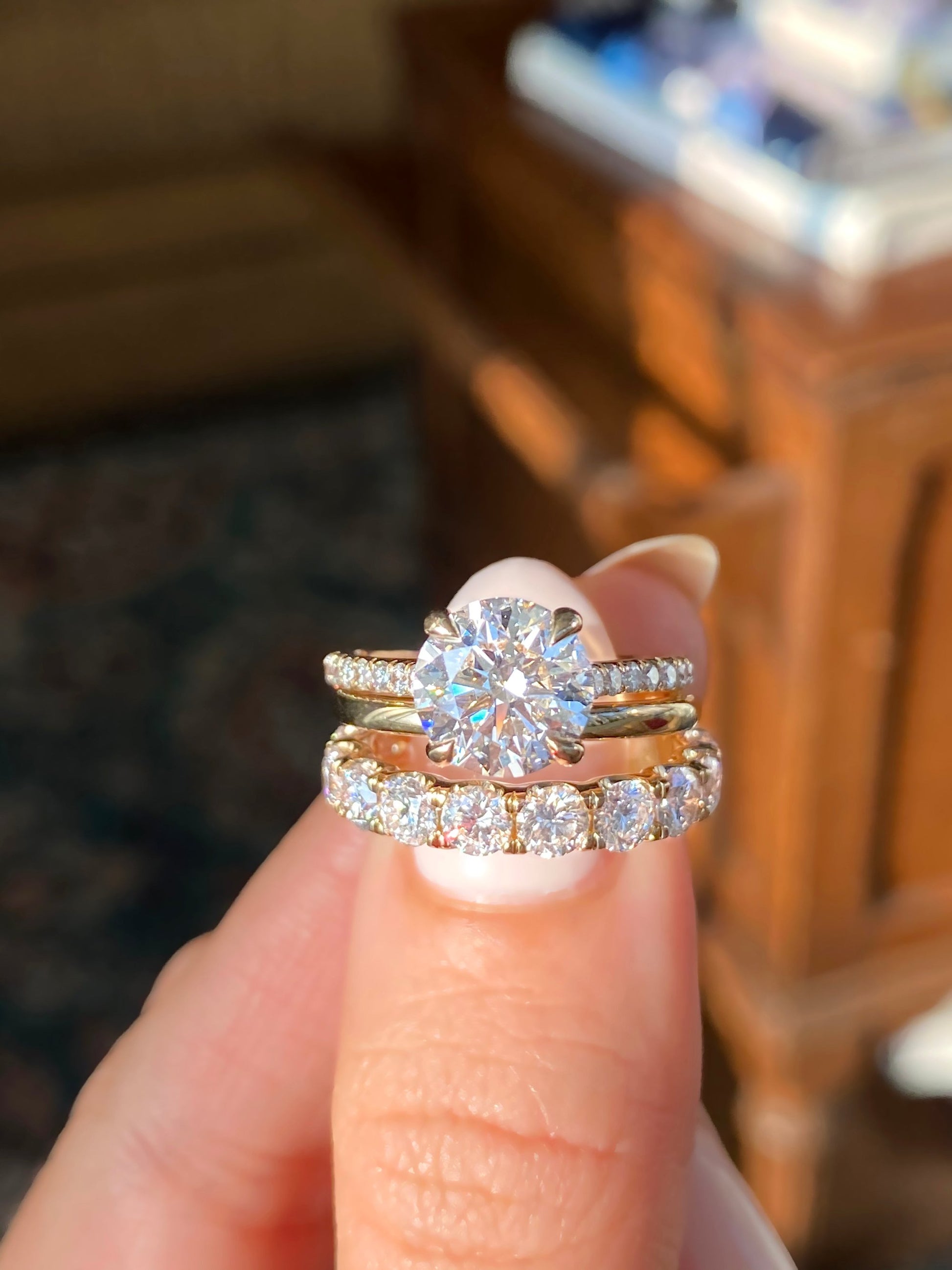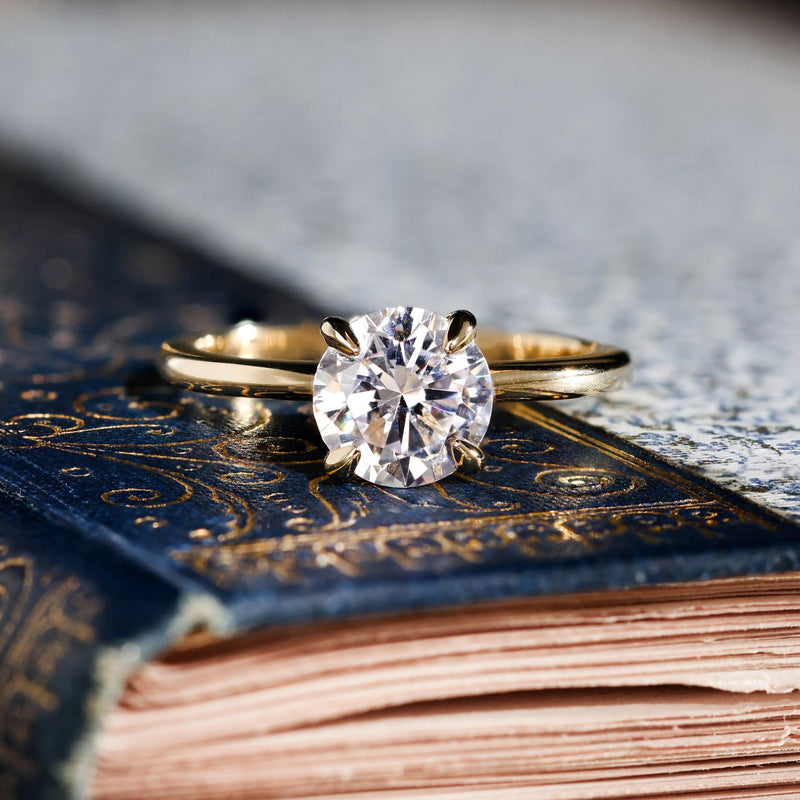Comprehending the Advantages of Lab Grown Diamond Engagement Rings in Today's Market
Lab-grown Diamond involvement rings are becoming increasingly popular in today's market. These choices to mined rubies offer a variety of advantages that appeal to modern customers. From ecological sustainability to cost savings, lab-grown diamonds offer a compelling option. Their improved top quality and personalization choices better add to their attraction. The growing rate of interest elevates concerns about the effects of these selections. What aspects should couples take into consideration when choosing lab-grown over traditional diamonds?
The Environmental Benefits of Lab-Grown Diamonds
As customers increasingly prioritize sustainability, lab-grown diamonds become a compelling choice to their extracted counterparts. These artificial gems are generated in regulated environments, noticeably reducing the eco-friendly impact related to traditional Diamond mining. The removal of all-natural diamonds typically leads to environment devastation, dirt disintegration, and water contamination, devastating regional ecological communities. In comparison, lab-grown diamonds call for less land and water, decreasing resource deficiency.
The energy utilized in the production of lab-grown rubies can be sourced from eco-friendly power, further reducing their ecological impact. This procedure not only visuals carbon discharges but likewise advertises sustainable practices within the jewelry industry. Customers who choose lab-grown diamonds add to an extra ecologically friendly and ethical market, aligning their buying choices with their worths. Generally, lab-grown rubies provide a solution that balances high-end with ecological duty, interesting an expanding group concerned concerning sustainability.
Cost-Effectiveness of Lab-Grown Interaction Rings
While lots of couples seek to stabilize high quality and spending plan when picking engagement rings, lab-grown diamonds supply an economical alternative without jeopardizing on charm or resilience. Generally priced 20-40% less than their all-natural counterparts, lab-grown rubies enable pairs to assign their spending plan a lot more flexibly, allowing bigger carat weight dimensions or better rocks for the very same rate. This price does not diminish the visual allure; lab-grown diamonds show the very same brilliance and clarity as mined rubies, thanks to similar chemical and physical residential properties. Furthermore, the marketplace for lab-grown diamonds is increasing, causing affordable prices and enhanced schedule. Pairs can also appreciate a larger variety of designs and settings without the economic pressure frequently connected with standard diamonds. Overall, lab-grown interaction rings present an attractive monetary option, making them progressively popular among modern pairs that focus on both cost and top quality in their investing in decisions.
Honest Considerations in Picking Lab-Grown Diamonds

Customers are progressively worried regarding the origins of their purchases, and lab-grown rubies supply a clear supply chain. Each Diamond features accreditation outlining its production procedure, making certain purchasers can make educated selections. The manufacturing of these rubies usually uses renewable energy sources, further aligning with eco-conscious values. For people prioritizing moral intake, lab-grown rubies provide an accountable alternative that combines luxury with moral integrity, appealing to modern sensibilities in engagement ring choices.

Top quality and Charm: Contrasting Lab-Grown and Mined Diamonds
The contrast in between lab-grown and extracted rubies discloses notable distinctions in aesthetic features and resilience. Lab-grown diamonds commonly display remarkable quality and shade uniformity, while extracted rubies can offer one-of-a-kind incorporations and variations. Additionally, both types share the same solidity, making them similarly suitable for involvement rings.
Aesthetic Features Contrast
Just how do lab-grown diamonds compare to their mined equivalents regarding aesthetic attributes? Both kinds of rubies share similar physical and chemical residential or commercial properties, making it challenging to distinguish in between them without specialized equipment. Lab-grown diamonds commonly show less imperfections and additions, leading to remarkable quality. Furthermore, they can be created in a wider variety of colors, enabling one-of-a-kind customization options. While extracted rubies are prized for their natural beginning and regarded rarity, lab-grown rubies can achieve equal charm and brilliance, typically at a reduced cost. Ultimately, the choice between the two may come down to personal choice, however visually, lab-grown rubies stand as an engaging option, boasting high quality that equals their all-natural equivalents.
Toughness and Solidity Elements
While both lab-grown and extracted rubies have phenomenal durability, their firmness stays a defining particular that emphasizes their suitability for daily wear. Rubies are ranked a 10 on the Mohs scale of mineral solidity, making them the hardest natural product known (lab grown diamond engagement rings). This characteristic warranties that both sorts of diamonds withstand damaging and preserve their sparkle in time. Lab-grown rubies, produced under controlled conditions, exhibit the exact same firmness and physical buildings as their mined counterparts. As a result, they supply a appealing and resistant option for engagement rings. Consumers can with confidence choose either type, recognizing read what he said that both give enduring high quality. Inevitably, the selection between lab-grown and mined diamonds might boil down to personal values instead of differences in resilience or solidity
Customization Options for Lab-Grown Diamonds
Lab-grown diamonds supply a variety of modification options that deal with individual preferences. From special design possibilities to different shade and cut selections, these diamonds can be customized to match any kind of individual style. This degree of customization guarantees that each engagement ring can mirror the distinct preferences of the user.
One-of-a-kind Style Possibilities
Numerous style possibilities wait for those thinking about lab-grown Diamond interaction rings, permitting pairs to express their distinct love tales. With the flexibility of lab-grown diamonds, developers can explore a wide variety of designs, from timeless jewelry to detailed vintage settings. Couples can select from different shapes, such as round, princess, or emerald cuts, each providing an unique character. In addition, the capacity to pick distinct metal types, consisting of white my site gold, climbed gold, or platinum, further improves modification. Lab-grown diamonds can additionally be fairly sourced in various carat weight weights, allowing couples to discover the best equilibrium in between dimension and budget. This adaptability enables each ring to mirror the specific preferences and choices of the couple, making it an absolutely individual sign of their dedication.
Personalization for each Design
The adaptability of lab-grown rubies prolongs beyond one-of-a-kind design opportunities, supplying considerable modification alternatives to fit every pair's style. Pairs can select from numerous setups, metals, and band styles, ensuring that their engagement ring reflects their originality. Options range from traditional jewelry to modern-day halo styles, permitting personal expression in every selection. Additionally, couples can choose particular features such as inscription, adding sentimental worth and individuality to their rings. The capacity to personalize guarantees that each ring is not only a depiction of love yet likewise a reflection of individual taste and way of living. This degree of customization makes lab-grown rubies an enticing option for those looking for a purposeful and unique interaction ring.
Color and Cut Options
Engagement rings including lab-grown diamonds supply a spectacular range of color and cut selections that improve their allure useful site and individuality. Unlike conventional rubies, lab-grown options can be produced in an extensive array of colors, consisting of pink, blue, and yellow, permitting pairs to pick a distinctly individual touch. These vivid shades can serve as a purposeful representation of love and dedication.
Lab-grown diamonds come in different cuts, consisting of oval, princess, and round, each adding to the stone's sparkle and aesthetic allure. This convenience enables pairs to personalize their rings to show their styles and choices. Inevitably, the availability of diverse color and cut alternatives makes lab-grown Diamond interaction rings a popular choice for modern pairs seeking personalization.
Fads and Popularity of Lab-Grown Diamonds in 2023
As consumers progressively prioritize sustainability and honest factors to consider in their investing in decisions, the popularity of lab-grown rubies has surged in 2023. This year, the marketplace has actually seen a remarkable shift, with even more couples going with these rubies because of their reduced environmental effect and clear sourcing processes. Lab-grown rubies are not only significantly much more budget-friendly than their extracted counterparts, however they additionally offer a selection of layouts and personalization alternatives that appeal to modern customers.
Stores have reacted to this expanding trend by increasing their collections and stressing the unique top qualities of lab-grown stones, such as their sparkle and clearness. Social media and influencer endorsements have additionally intensified understanding, making lab-grown diamonds a stylish option for engagement rings. As education regarding the advantages remains to spread, it is anticipated that the marketplace share of lab-grown rubies will remain to climb, strengthening their place in the precious jewelry industry.
Regularly Asked Concerns
Just How Are Lab-Grown Diamonds Produced in a Research laboratory?
Lab-grown diamonds are created making use of two key techniques: High Stress Heat (HPHT) simulates natural Diamond development conditions, while Chemical Vapor Deposition (CVD) utilizes gas to precipitate carbon onto a substratum, creating diamonds layer by layer.
Do Lab-Grown Rubies Hold Their Worth In Time?
Lab-grown rubies generally do not hold their value along with all-natural rubies. Market fluctuations and customer perceptions affect resale prices, bring about lower lasting value retention for lab-grown alternatives compared to their all-natural equivalents.
Can Lab-Grown Diamonds Be Resized Like Mined Diamonds?
Lab-grown rubies can be resized similarly to mined diamonds, as they possess comparable physical properties. Jewelers commonly employ common methods for resizing, guaranteeing that both sorts of rubies maintain their stability and visual allure during the procedure.
Are Lab-Grown Diamonds Available in Numerous Shapes and Sizes?
Lab-grown diamonds are without a doubt available in a selection of dimensions and shapes. They can be tailored to satisfy specific preferences, offering choices like round, princess, oval, and emerald cuts, to name a few, guaranteeing diverse choices for customers.
Exactly how Do I Verify the Authenticity of a Lab-Grown Diamond?
To confirm the credibility of a lab-grown Diamond, one ought to speak with a trusted gemologist or acquire a qualification from an identified grading lab, which usually includes details concerning the Diamond's origin and attributes.
Lab-grown rubies are created in controlled atmospheres, removing the ecological devastation commonly associated with standard Diamond mining. lab grown diamond engagement rings. Lab-grown rubies frequently exhibit premium clearness and shade consistency, while mined diamonds can provide special incorporations and variations. While extracted rubies are treasured for their natural beginning and regarded rarity, lab-grown diamonds can achieve equivalent charm and luster, frequently at a lower cost. Lab-grown diamonds normally do not hold their worth as well as all-natural rubies. Lab-grown rubies can be resized likewise to extracted rubies, as they possess comparable physical buildings